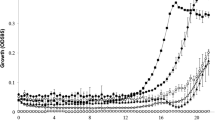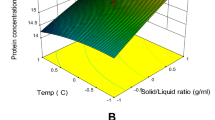Abstract
Antibacterial peptide fractions generated via proteolytic processing of snow crab by-products exhibited activity against Gram-negative and Gram-positive bacteria. Among the bacterial strains tested, peptide fractions demonstrated inhibitory activity against the Gram-negative bacteria such as Aeromonas caviae, Aeromonas hydrophila, Campylobacter jejuni, Listonella anguillarum, Morganella morganii, Shewanella putrefasciens, Vibrio parahaemolyticus and Vibrio vulnificus and against a few Gram-positive bacteria such as Listeria monocytogenes, Staphylococcus epidermidis and Streptococcus agalactiae. The principal bioactive peptide fraction was comprised mainly of proteins and minerals (74.3 and 15.5%, respectively). Lipids were not detected. The amino acid content revealed that arginine (4.6%), glutamic acid (5.3%) and tyrosine (4.8%) residues were represented in the highest composition in the antibacterial peptide fraction. The optimal inhibitory activity was observed at alkaline pH. The V. vulnificus strain, most sensitive to the peptide fraction, was used to develop purification methods. The most promising chromatography resins selected for purification, in order to isolate peptides of interest and to carry out their detailed biochemical characterization, were the SP-Sepharose™ Fast Flow cation exchanger and the Phenyl Sepharose™ High Performance hydrophobic interaction media. The partially purified antibacterial peptide fraction was analyzed for minimum inhibitory concentration (MIC) determination, and the value obtained was 25 μg ml−1. Following mass spectrometry analysis, the active peptide fraction seems to be a complex of molecules comprised of several amino acids and other organic compounds. In addition, copper was the main metal found in the active peptide fraction. Results indicate the production of antibacterial molecules from crustacean by-products that support further applications for high-value bioproducts in several areas such as food and health.




Similar content being viewed by others
References
A.O.A.C (2002) Official methods of analysis of the Association of Official Analytical Chemists. 17th edn. In: Horwitz W (ed) Association of official analytical chemists. Washington, Methods no 950.46 and 938.08 and 988.05
Bartlett TC, Cuthbertson BJ, Shepard EF, Chapman RW, Gross PS, Warr GW (2002) Crustins, homologues of an 11.5-kDa antibacterial peptide, from two species of Penaeid shrimp, Litopenaeus vannamei and Litopenaeus setiferus. Mar Biotechnol 4:278–293
Battison AL, Summerfield R, Patrzykat A (2008) Isolation and characterization of two antimicrobial peptides from haemocytes of the American lobster Homarus americanus. Fish Shellfish Immunol. 25:181–187
Beaulieu L, Thibodeau J, Bryl P, Carbonneau M-É (2009) Characterization of enzymatic hydrolysated snow crab (Chionoecetes opilio) by-product fractions: a source of high-valued biomolecules. Biores Technol 100:3332–3342
Beltramini M, Colangelo N, Giomi F, Bubacco L, Di Muro P, Hellmann N, Jeanicke E, Decker H (2005) Quaternary structure and functional properties of Penaeus monodon hemocyanin. FEBS J 272:2060–2075
Bligh EG, Dyer WJ (1959) A rapid method of total lipid extraction and purification. Can J Biochem Phys 37:911–917
Boman HG (2003) Antibacterial peptides: basic facts and emerging concepts. J Intern Med 254:197–215
Brogden KM, Ackermann M, McCray PB, Tack BF (2003) Antimicrobial peptides in animals and their role in host defences. Int J Antimicrob Agents 22:465–478
Brogden KA, De Lucca AJ, Bland J, Elliot S (1996) Isolation of an ovine pulmonary surfactant-associated anionic peptide bactericidal for Pasteurella haemolytica. Proc Natl Acad Sci USA 93:412–416
Cancilla MT, Wong AM, Voss LR, Lebrilla CB (1999) Fragmentation reactions in the mass spectrometry analysis of neutral oligosaccharides. Anal Chem 71:3206–3218
Destoumieux D, Bulet P, Loew D, Dorsselaer AV, Rodriguez J, Bachère E (1997) Penaeidins, a new family of antimicrobial peptides isolated from the shrimp Penaeus vannamei (Decapoda). J Biol Chem 272:28398–28406
Destoumieux-Garzon D, Saulnier D, Garnier J, Jouffrey C, Bulet P, Bachère E (2001) Antifungal peptides are generated from the C-terminus of shrimp hemocyanin in response to microbial challenge. J Biol Chem 276:47070–47077
Elsbach P, Weiss J (1998) Role of the bactericidal/permeability-increasing protein in host defence. Curr Opin Immunol 10:45–49
Faghri MA, Pennington CL, Cronholm LS, Atlas RM (1984) Bacteria associated with crabs from cold waters with emphasis on the occurrence of potential human pathogens. Appl Env Microbiol 47:1054–1061
Gross PS, Bartlett TC, Browdy CL, Chapman RW, Warr GW (2001) Immune gene discovery by expressed sequence tag analysis of hemocytes and hepatopancreas in the Pacific white shrimp, Litopenaeus vannamei, and the Atlantic white shrimp, L. setiferus. Dev Comp Immunol 25:565–577
Hancock REW, Brown KL, Mookherjee N (2006) Host defense peptides from invertebrates—emerging antimicrobial strategies. Immunobiol 211:315–322
Haug T (2004) Marine bioprospecting: marine invertebrates and algae—a potential source for the discovery of novel antibiotics. Doctor scientiarum thesis, University of Tromso, Norway
Haug T, Kjuul AK, Stensvag K, Sandsdalen E, Styrvold OB (2002) Antibacterial activity in four marine crustaceans decapods. Fish Shellfish Immunol 12:371–385
Herbinière J, Braquart-Varnier C, Grève P, Strub J-M, Frère J, Dorsselaer AV, Martin G (2005) Armadillidin: a novel glycine-rich antibacterial peptide directed against gram-positive bacteria in the woodlouse Armadillidium vulgare (terrestrial isopod, crustacean). Dev Comp Immunol 29:489–499
Himelbloom B, Nilsson L, Gram L (2001) Factors affecting production of an antilisterial bacteriocin by Carnobacterium piscicola strain A9b in laboratory media and model fish systems. J Appl Microbiol 91:506–513
Idakieva K, Stoeva S, Voelter W, Gielens C (2004) Glycosylation of Rapana thomsiana hemocyanin. Comparison with other prosobranch (gastropod) hemocyanins. Comp Biochem Physiol Part B 138:221–228
Iwanaga S, Lee BL (2005) Recent advances in the innate immunity of invertebrates animals. J Biochem Mol Biol 38:128–150
Khoo L, Robinette DW, Noga EJ (1999) Callinectin, an antibacterial peptide from blue crab, Callinectes sapidus, hemocytes. Mar Biotechnol 1:44–51
Lee SY, Lee BL, Söderhäll K (2003) Processing of an antibacterial peptide from hemocyanin of the freshwater crayfish Pacifastacus leniusculus. J Biol Chem 278:7927–7933
Leitner A, Emmert J, Boerner K, Lindner W (2007) Influence of solvent additive composition on chromatographic separation and sodium adduct formation of peptides in HPLC-ESI MS. Chromatographia 65:649–653
Liu Z, Dong S, Xu J, Zeng M, Song H, Zhao Y (2008) Production of cysteine-rich antimicrobial peptide by digestion of oyster (Crassostrea gigas) with alcalase and bromelin. Food Control 19:231–235
Marr AK, Gooderham WJ, Hancock REW (2006) Antibacterial peptides for therapeutic use: obstacles and realistic outlook. Curr Opin Pharmacol 6:468–472
Marshall SH, Arenas G (2003) Antimicrobial peptides: a natural alternative to chemical antibiotics and a potential for applied biotechnology. Elect J Biotechnol 6:271–284
Noga EJ, Smolowitz R, Khoo LH (2000) Pathology of shell disease in the blue crab, Callinectes sapidus Rathbun, (Decapoda: Portunidae). J Fish Dis 23:389–399
Patat SA, Carnegie RB, Kingsbury C, Gross PS, Chapman R, Schev KL (2004) Antimicrobial activity of histones from hemocytes of the Pacific white shrimp. Eur J Biochem 271:4825–4833
Patrzykat A, Douglas SE (2003) Gone gene fishing: how to catch novel marine antimicrobials. Trends Biotechnol 21:362–369
Powers JPS, Hancock REW (2003) The relationship between peptide structure and antibacterial activity. Peptides 24:1681–1691
Relf JM, Chisholm JRS, Kemp GD, Smith VJ (1999) Purification and characterization of a cystein-rich 11.5-kDa antibacterial protein from the granular haemocytes of the shore crab, Carcinus maenas. Eur J Biochem 264:350–357
Rojtinnakorn J, Hirono I, Itami T, Takahashi Y, Aoki T (2002) Gene expression in haemocytes of kuruma prawn, Penaeus japonicus, in response to infection with WSSV by EST approach. Fish Shellfish Immun 13:69–83
Schnapp D, Kemp GD, Smith VJ (1996) Purification and characterization of a proline-rich antibacterial peptide, with sequence similarity to bactenecin-7, from the haemocytes of the shore crab, Carcinus maenas. Eur J Biochem 240:532–539
Smith VJ, Chisholm JRS (2001) Antimicrobial proteins in crustaceans. Adv Exp Med Biol 484:95–112
Stensvag K, Haug T, Sperstad SV, Rekdal O, Indrevoll B, Styrvold OB (2008) Arasin 1, a proline-arginine-rich antimicrobial peptide isolated from the spider crab, Hyas araneus. Dev Comp Immunol 32:275–285
Supungul P, Klinbunga S, Pichyangkura R, Jitrapakdee S, Hirono I, Aoki T, Tassanakajon A (2002) Identification of immune-related genes in hemocytes of black tiger shrimp (Penaeus monodon). Mar Biotechnol 4:487–494
Tincu JA, Taylor SW (2004) Antimicrobial peptides from marine invertebrates. Antimicrob Agents Ch 48:3645–3654
Tome E, Gibbs PA, Teixeira PC (2008) Growth control of Listeria innocua 2030c on vacuum-packaged cold-smoked salmon by lactic acid bacteria. Int J Food Microbiol 121:285–294
Wang KJ, Huang WS, Yang M, Chen HY, Bo J, Li SJ, Wang GZ (2007) A male-specific expression gene, encodes a novel anionic antimicrobial peptide, scygonadin, in Scylla serrata. Mol Immunol 44:1961–1968
Zasloff M (2002) Antimicrobial peptides of multicellular organisms. Nature 415:389–395
Acknowledgments
The authors wish to thank E. Gagnon et Fils Lté (Grande-Rivière, Québec, Canada) for providing the snow crab by-products, Mr. Piotr Bryl, Mrs. Marie-Élise Carbonneau, Mrs. Nadine Renaud, Mr. Michel Parisé and Mrs. Diane Ouellet (Aquatic Products Technology Centre, Gaspé, Québec, Canada) for their scientific input and technical expertise. We thank Mrs. Christine Barthe (MAPAQ) for providing several bacterial strains. Thanks also to Mrs Maria Pacheco-Oliver (Biotechnology Research Institute, National Research Council, BRI-NRC) for her presubmission review of this paper. Lucie Beaulieu would like to thank the Innovation and Technologies Directorate of Ministère de l’agriculture, des pêcheries et de l’alimentation (MAPAQ, Québec, Canada) and Ministère du développement économique, de l’innovation et de l’exportation (MDEIE, Québec, Canada) for their financial support.
Author information
Authors and Affiliations
Corresponding author
Rights and permissions
About this article
Cite this article
Beaulieu, L., Thibodeau, J., Desbiens, M. et al. Evidence of Antibacterial Activities in Peptide Fractions Originating from Snow Crab (Chionoecetes opilio) By-Products. Probiotics & Antimicro. Prot. 2, 197–209 (2010). https://doi.org/10.1007/s12602-010-9043-6
Published:
Issue Date:
DOI: https://doi.org/10.1007/s12602-010-9043-6




